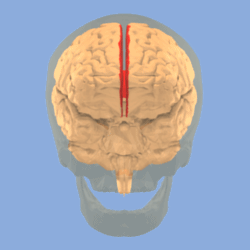Longitudinal fissure facts for kids
In animals with backbones, like humans, the longitudinal fissure is a deep groove. It divides the cerebrum, which is the largest part of the brain, into two halves. These two halves are often called the cerebral hemispheres. Think of it like a deep valley separating two mountains.
Contents
What is the Longitudinal Fissure?
The longitudinal fissure is a long, narrow groove found in the brain. It runs from the front to the back of the cerebrum. This important feature helps to clearly separate the left and right sides of your brain. It's sometimes called the 'great longitudinal fissure' or 'interhemispheric fissure'.
The Brain's Two Halves
Your brain's cerebrum is divided into two main parts: the left hemisphere and the right hemisphere. Each hemisphere controls different functions and parts of your body. For example, the left hemisphere often handles language and logic. The right hemisphere is usually more involved in creativity and spatial awareness. The longitudinal fissure is the visible line that marks this division.
Connecting the Hemispheres
Even though the longitudinal fissure separates the two hemispheres, they are not completely disconnected. A thick bundle of nerve fibres connects them. This bundle is called the corpus callosum. It acts like a superhighway, allowing the left and right sides of your brain to communicate. This constant communication helps your brain work together smoothly.
Protecting the Fissure
The longitudinal fissure, like other parts of your brain, is protected. A tough, protective membrane covers this deep groove. This membrane is known as the falx cerebri. It helps to keep the two brain hemispheres from pressing against each other. It also provides support and protection to the delicate brain tissue.
Images for kids
See also
 In Spanish: Cisura interhemisférica para niños
In Spanish: Cisura interhemisférica para niños






